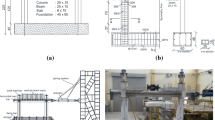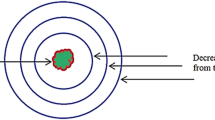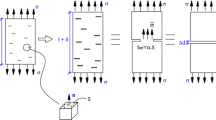Abstract
The present work proposes a methodology to analyze the identification of constitutive model parameters for concrete. This procedure is an important step to develop reliable constitutive models for materials with complex mechanical behavior, as concrete. A parametric sensitivity analysis has been developed using a damage model applied to concrete performing numerical analyses in uniaxial states and plain concrete plate. To solve the identification problem, an inverse optimization technique based on bio-inspired computational algorithm has been applied. To validate the inverse problem results, reinforced concrete beams found in the literature have been used. Thus, a comparison between experimental results and the ones obtained from the proposed technique has been made observing an adherence index about 95%. Finally, it is possible to note that the proposed methodology is robust and efficient concerning to the automatization of the parametric identification problem discussed on this paper when compared to traditional techniques used in Structural Engineering in the context of damage constitutive models.



















Similar content being viewed by others
References
Liu, T.; Zhang, X.; He, N.; Jia, G.: Numerical Material Model for Composite Laminates in High-Velocity Impact Simulation. Lat. Am. J. Solids Struct. 14, 1912–1931 (2017). https://doi.org/10.1590/1679-78253750
Sirois, F.; Grilli, F.: Potential and limits of numerical modelling for supporting the development of HTS devices. Supercond. Sci. Technol. 28, 043002 (2015). https://doi.org/10.1088/0953-2048/28/4/043002
Steinhauser, M.; Hiermaier, S.: A review of computational methods in materials science: examples from shock-wave and polymer physics. IJMS 10, 5135–5216 (2009). https://doi.org/10.3390/ijms10125135
Vlcek, L.; Vasudevan, R.K.; Jesse, S.; Kalinin, S.V.: Consistent integration of experimental and ab initio data into effective physical models. J. Chem. Theory Comput. 13, 5179–5194 (2017). https://doi.org/10.1021/acs.jctc.7b00114
Khalfallah, A.; Bel Hadj Salah, H.; Dogui, A.: Anisotropic parameter identification using inhomogeneous tensile test. Eur. J. Mech. A/Solids 21, 927–942 (2002). https://doi.org/10.1016/S0997-7538(02)01246-9
Barabasz, B.; Gajda-Zagórska, E.; Migórski, S.; Paszyński, M.; Schaefer, R.; Smołka, M.: A hybrid algorithm for solving inverse problems in elasticity. Int. J. Appl. Math. Comput. Sci. 24, 865–886 (2014). https://doi.org/10.2478/amcs-2014-0064
Murray-Smith, D.J.: The inverse simulation approach: a focused review of methods and applications. Math. Comput. Simul. 53, 239–247 (2000). https://doi.org/10.1016/S0378-4754(00)00210-X
Wardeh, M.A.; Toutanji, H.A.: Parameter estimation of an anisotropic damage model for concrete using genetic algorithms. Int. J. Damage Mech. 26, 801–825 (2017). https://doi.org/10.1177/1056789515622803
Rechenmacher, A.L.; Medina-Cetina, Z.: Calibration of soil constitutive models with spatially varying parameters. J. Geotech. Geoenviron. Eng. 133, 1567–1576 (2007). https://doi.org/10.1061/(ASCE)1090-0241(2007)133:12(1567)
Zagho, M.; Hussein, E.; Elzatahry, A.: Recent overviews in functional polymer composites for biomedical applications. Polymers 10, 739 (2018). https://doi.org/10.3390/polym10070739
Brünig, M.; Michalski, A.: Numerical analysis of damage and failure behavior of concrete. Int. J. Damage Mech 29, 570–590 (2020). https://doi.org/10.1177/1056789519866005
Marie, I.; Mahdi, M.: Numerical simulation of concrete mix structure and detection of its elastic stiffness. J. Comput. Eng. Phys. Model. (2018). https://doi.org/10.22115/cepm.2018.54011
Ožbolt, J.; Sharma, A.: Numerical simulation of reinforced concrete beams with different shear reinforcements under dynamic impact loads. Int. J. Impact Eng. 38, 940–950 (2011). https://doi.org/10.1016/j.ijimpeng.2011.08.003
Jin, L.; Zhang, S.; Li, D.; Xu, H.; Du, X.; Li, Z.: A combined experimental and numerical analysis on the seismic behavior of short reinforced concrete columns with different structural sizes and axial compression ratios. Int. J. Damage Mech. 27, 1416–1447 (2018). https://doi.org/10.1177/1056789517735679
Grassl, P.; Jirásek, M.: Damage-plastic model for concrete failure. Int. J. Solids Struct. 43, 7166–7196 (2006). https://doi.org/10.1016/j.ijsolstr.2006.06.032
Peng, Y.; Chu, H.; Pu, J.: Numerical simulation of recycled concrete using convex aggregate model and base force element method. Adv. Mater. Sci. Eng. 2016, 1–10 (2016). https://doi.org/10.1155/2016/5075109
Holzapfel, G.A.; Fereidoonnezhad, B.: Modeling of damage in soft biological tissues. In: Biomechanics of living organs, pp. 101–123. Elsevier (2017). https://doi.org/10.1016/B978-0-12-804009-6.00005-5
Ozbolt, J.; Ananiev, S.: Scalar damage model for concrete without explicit evolution law. ArXiv:07042663 [Cond-Mat] (2007)
Pereira Junior, W.M.; Araújo, D.L.; Pituba, J.J.C.: Numerical analysis of steel-fiber-reinforced concrete beams using damage mechanics. Rev. IBRACON Estrut. Mater. 9, 153–191 (2016). https://doi.org/10.1590/S1983-41952016000200002
Sawangikar, M.M.S.; Burande, D.C.S.; Burande, D.B.C.: Irreversible thermodynamics: a review. 02, 7 (2016)
Alastrué, V.; Rodríguez, J.F.; Calvo, B.; Doblaré, M.: Structural damage models for fibrous biological soft tissues. Int. J. Solids Struct. 44, 5894–5911 (2007). https://doi.org/10.1016/j.ijsolstr.2007.02.004
Malcher, L.; Mamiya, E.N.: An improved damage evolution law based on continuum damage mechanics and its dependence on both stress triaxiality and the third invariant. Int. J. Plast. 56, 232–261 (2014). https://doi.org/10.1016/j.ijplas.2014.01.002
Li, W.: Damage models for soft tissues: a survey. J. Med. Biol. Eng. 36, 285–307 (2016). https://doi.org/10.1007/s40846-016-0132-1
Bai, Q.; Mohamed, M.; Shi, Z.; Lin, J.; Dean, T.: Application of a continuum damage mechanics (CDM)-based model for predicting formability of warm formed aluminium alloy. Int. J. Adv. Manuf. Technol. 88, 3437–3446 (2017). https://doi.org/10.1007/s00170-016-8853-4
Williams, K.V.; Vaziri, R.: Application of a damage mechanics model for predicting the impact response of composite materials. Comput. Struct. 79, 997–1011 (2001). https://doi.org/10.1016/S0045-7949(00)00200-5
Cipollina, A.; Flórez, L.J.: Modelos simplificados de daño en pórticos de concreto armado. Revista Internacional de Métodos Numéricos Para Cálculo y Diseño En Ingeniería 11, 3–22 (1995)
Comi, C.: A non-local model with tension and compression damage mechanisms. Eur. J. Mech. A. Solids 20, 1–22 (2001). https://doi.org/10.1016/S0997-7538(00)01111-6
Comi, C.; Perego, U.: Fracture energy based bi-dissipative damage model for concrete. Int. J. Solids Struct. 38, 6427–6454 (2001). https://doi.org/10.1016/S0020-7683(01)00066-X
Juárez-Luna, G.; Méndez-Martínez, H.; Ruiz-Sandoval, M.E.: An isotropic damage model to simulate collapse in reinforced concrete elements. Lat. Am. J. Solids Struct. 11, 2444–2459 (2014). https://doi.org/10.1590/S1679-78252014001300007
Wang, Z.; Jin, X.; Jin, N.; Shah, A.A.; Li, B.: Damage based constitutive model for predicting the performance degradation of concrete. Lat. Am. J. Solids Struct. 11, 907–924 (2014). https://doi.org/10.1590/S1679-78252014000600001
Pituba, J.J.C.; Pereira Júnior, W.M.: A bi-dissipative damage model for concrete. Rev. IBRACON Estrut. Mater. 8, 49–65 (2015). https://doi.org/10.1590/S1983-41952015000100006
Pituba, J.J.C.; Fernandes, G.R.: Anisotropic damage model for concrete. J. Eng. Mech. 137, 610–624 (2011). https://doi.org/10.1061/(ASCE)EM.1943-7889.0000260
Pituba, J.J.C.; Lacerda, M.M.S.: Simplified damage models applied in the numerical analysis of reinforced concrete structures. Rev IBRACON Estrut. Mater. 5, 26–37 (2012). https://doi.org/10.1590/S1983-41952012000100004
Cicekli, U.; Voyiadjis, G.Z.; Abu Al-Rub, R.K.: A plasticity and anisotropic damage model for plain concrete. Int. J. Plast 23, 1874–1900 (2007). https://doi.org/10.1016/j.ijplas.2007.03.006
Zhou, F.; Cheng, G.: A coupled plastic damage model for concrete considering the effect of damage on plastic flow. Math. Probl. Eng. 2015, 1–13 (2015). https://doi.org/10.1155/2015/867979
Mazars, J.; Hamon, F.; Grange, S.: A new 3D damage model for concrete under monotonic, cyclic and dynamic loadings. Mater. Struct. 48, 3779–3793 (2015). https://doi.org/10.1617/s11527-014-0439-8
Omidi, O.; Lotfi, V.: Finite element analysis of concrete structures using plasticdamage model in 3-D implementation. 8, 17 (2010)
Pituba, J.J.C.; Neto, E.A.S.: Modeling of unilateral effect in brittle materials by a mesoscopic scale approach. Comput. Concr. 15, 735–758 (2015). https://doi.org/10.12989/CAC.2015.15.5.735
Pituba, J.J.C.: A damage model formulation: unilateral effect and RC structures analysis. Comput. Concr. 15, 709–733 (2015). https://doi.org/10.12989/CAC.2015.15.5.709
Nghia Nguyen, T.; Le, T.C.; Kathir, S.; Abdel, W.M.: A novel approach to the complete stress strain curve for plastically damaged concrete under monotonic and cyclic loads. Comput. Concr. 28, 39–53 (2021). https://doi.org/10.12989/CAC.2021.28.1.039
Krejčí, T.; Koudelka, T.; Bernardo, V.; Šejnoha, M.: Effective elastic and fracture properties of regular and irregular masonry from nonlinear homogenization. Comput. Struct. 254, 106580 (2021). https://doi.org/10.1016/j.compstruc.2021.106580
Fichant, S.; La Borderie, C.; Pijaudier-Cabot, G.: A comparative study of isotropic and anisotropic descriptions of damage in concrete structures. Stud. Appl. Mech. 46, 259–274 (1998). https://doi.org/10.1016/S0922-5382(98)80046-9
Arslan, A.; Gümüş, M.: A simple and robust approach for 2D-simulation of reinforced concrete member. Structures 32, 1701–1716 (2021). https://doi.org/10.1016/j.istruc.2021.03.050
Amorim, D.L.N.D.F.; Proença, S.P.B.; Flórez-López, J.: Simplified modeling of cracking in concrete: application in tunnel linings. Eng. Struct. 70, 23–35 (2014). https://doi.org/10.1016/j.engstruct.2014.03.031
Mazars, J.; Pijaudier-Cabot, G.: Continuum damage theory—application to concrete. J. Eng. Mech. 115, 345–365 (1989). https://doi.org/10.1061/(ASCE)0733-9399(1989)115:2(345)
Wang, Y.; Zhang, B.; Li, B.; Li, C.: A strain-based fatigue damage model for naturally fractured marble subjected to freeze-thaw and uniaxial cyclic loads. Int. . Damage Mech. (2021). https://doi.org/10.1177/10567895211021629
Guo, Y.; Liu, G.; Liu, H.; Huang, Y.: Creep damage model considering unilateral effect based on bimodulus theory. Int. J. Damage Mech. (2021). https://doi.org/10.1177/10567895211017319
Junior, W.M.P.; Borges, R.A.; Araújo, D.L.; Pituba, J.J.C.: A proposal to use the inverse problem for determining parameters in a constitutive model for concrete. Soft Comput 25, 8797–8815 (2021). https://doi.org/10.1007/s00500-021-05745-x
Kang, F.; Li, J.; Xu, Q.: Structural inverse analysis by hybrid simplex artificial bee colony algorithms. Comput. Struct. 87, 861–870 (2009). https://doi.org/10.1016/j.compstruc.2009.03.001
Sun, H.; Luş, H.; Betti, R.: Identification of structural models using a modified artificial bee colony algorithm. Comput. Struct. 116, 59–74 (2013). https://doi.org/10.1016/j.compstruc.2012.10.017
Morio, J.: Global and local sensitivity analysis methods for a physical system. Eur. J. Phys. 32, 1577–1583 (2011). https://doi.org/10.1088/0143-0807/32/6/011
Link, K.G.; Stobb, M.T.; Di Paola, J.; Neeves, K.B.; Fogelson, A.L.; Sindi, S.S., et al.: A local and global sensitivity analysis of a mathematical model of coagulation and platelet deposition under flow. PLoS ONE 13, e0200917 (2018). https://doi.org/10.1371/journal.pone.0200917
Razavi, S.; Gupta, H.V.: What do we mean by sensitivity analysis? The need for comprehensive characterization of “global” sensitivity in earth and environmental systems models: a critical look at sensitivity analysis. Water Resour. Res. 51, 3070–3092 (2015). https://doi.org/10.1002/2014WR016527
Felmlee, M.A.; Krzyzanski, W.; Morse, B.L.; Morris, M.E.: Use of a local sensitivity analysis to inform study design based on a mechanistic toxicokinetic model for γ-hydroxybutyric acid. AAPS J. 13, 240–254 (2011). https://doi.org/10.1208/s12248-011-9264-y
Dong, Z.; Xie, L.; Yang, Y.; Bridgwater, A.V.; Cai, J.: local sensitivity analysis of kinetic models for cellulose pyrolysis. Waste Biomass Valor. 10, 975–984 (2019). https://doi.org/10.1007/s12649-017-0097-5
Czitrom, V.: One-factor-at-a-time versus designed experiments. Am. Stat. 53, 126–131 (1999). https://doi.org/10.1080/00031305.1999.10474445
Saltelli, A.: Sensitivity analysis: could better methods be used? J. Geophys. Res. 104, 3789–3793 (1999). https://doi.org/10.1029/1998JD100042
Mazars J. Application de la mecanique de l’endommagement au comportement non lineaire et a la rupture du beton de structure. Universite Pierre et Marie Curie: Laboratoire de Mecanique et Technologie (1984)
Gelim, J.-C.; Ghouati, O.: An inverse method for material parameters estimation in the inelastic range. Comput. Mech. 16, 143–150 (1995)
Viola, E.; Bocchini, P.: Non-destructive parametric system identification and damage detection in truss structures by static tests. Struct. Infrastruct. Eng. 9, 384–402 (2013). https://doi.org/10.1080/15732479.2011.560164
Andersson, D.C.; Lindskog, P.; Larsson, P.-L.: Inverse modeling applied for material characterization of powder materials. J. Test Eval. 43, 20130266 (2015). https://doi.org/10.1520/JTE20130266
Meraghni, F.; Chemisky, Y.; Piotrowski, B.; Echchorfi, R.; Bourgeois, N.; Patoor, E.: Parameter identification of a thermodynamic model for superelastic shape memory alloys using analytical calculation of the sensitivity matrix. Eur. J. Mech. A. Solids 45, 226–237 (2014). https://doi.org/10.1016/j.euromechsol.2013.12.010
Karaboga D. An idea based on Honey bee swarm for numerical optimization n.d.:10
Karaboga, D.; Basturk, B.: Artificial bee colony (ABC) optimization algorithm for solving constrained optimization problems. In: Melin, P.; Castillo, O.; Aguilar, L.T.; Kacprzyk, J.; Pedrycz, W. (Eds.) Foundations of fuzzy logic and soft computing, pp. 789–798. Springer, Berlin (2007). https://doi.org/10.1007/978-3-540-72950-1_77
Bacanin, N.; Tuba, M.: Artificial bee colony (ABC) algorithm for constrained optimization improved with genetic operators. Stud. Inform. ControlI (2012). https://doi.org/10.24846/v21i2y201203
Xu, Y.; Fan, P.; Yuan, L.: A simple and efficient artificial bee colony algorithm. Math. Probl. Eng. 2013, 1–9 (2013). https://doi.org/10.1155/2013/526315
Alkayem, N.F.; Cao, M.; Ragulskis, M.: Damage localization in irregular shape structures using intelligent FE model updating approach with a new hybrid objective function and social swarm algorithm. Appl. Soft Comput. 83, 105604 (2019). https://doi.org/10.1016/j.asoc.2019.105604
Taetragool, U.; Shah, P.H.; Halls, V.A.; Zheng, J.Q.; Batra, R.C.: Stacking sequence optimization for maximizing the first failure initiation load followed by progressive failure analysis until the ultimate load. Compos. Struct. 180, 1007–1021 (2017). https://doi.org/10.1016/j.compstruct.2017.08.023
Álvares M da S. Estudo de um modelo de dano para o concreto: formulação, identificação paramétrica e aplicação com o emprego do método dos elementos finitos. text. Universidade de São Paulo (1993)
Fédération Internationale du Béton. Model Code 2010, final draft. Lausanne: FIB (2012)
Fernandes, G.R.; Crozariol, L.H.R.; Furtado, A.S.; Santos, M.C.: A 2D boundary element formulation to model the constitutive behavior of heterogeneous microstructures considering dissipative phenomena. Eng. Anal. Boundary Elem. 99, 1–22 (2019). https://doi.org/10.1016/j.enganabound.2018.10.018
Fernandes, G.R.; Marques Silva, M.J.; Vieira, J.F.; Pituba, J.J.C.: A 2D RVE formulation by the boundary element method considering phase debonding. Eng. Anal. Boundary Elem. 104, 259–276 (2019). https://doi.org/10.1016/j.enganabound.2019.03.018
Yuuki, R.; Cao, G.: Shape optimization for stress concentration problems in orthotropic materials by using Boundary Element method. Boundary Element Methods (1990). https://doi.org/10.1016/B978-0-08-040200-0.50036-4
Fernandes, G.R.; Pituba, J.J.C.; de Souza Neto, E.A.: Multi-scale modelling for bending analysis of heterogeneous plates by coupling BEM and FEM. Eng. Anal. Boundary Elem. 51, 1–13 (2015). https://doi.org/10.1016/j.enganabound.2014.10.005
Mehta, P.K.; Monteiro, P.J.M.: Concrete: microstructure, properties, and materials, 4th edn. McGraw-Hill Education, New York (2014)
Rodrigues, E.A.; Manzoli, O.L.; Bitencourt, L.A.G., Jr.; dos Prazeres, P.G.C.; Bittencourt, T.N.: Failure behavior modeling of slender reinforced concrete columns subjected to eccentric load. Lat. Am. J. Solids Struct. 12, 520–541 (2015). https://doi.org/10.1590/1679-78251224
de Melo, G.L.; Fernandes, A.L.T.: Evaluation of empirical methods to estimate reference evapotranspiration in Uberaba, State of Minas Gerais. Brazil. Eng Agríc 32, 875–888 (2012). https://doi.org/10.1590/S0100-69162012000500007
Perin, V.; Sentelhas, P.C.; Dias, H.B.; Santos, E.A.: Sugarcane irrigation potential in Northwestern São Paulo, Brazil, by integrating Agrometeorological and GIS tools. Agric. Water Manag. 220, 50–58 (2019). https://doi.org/10.1016/j.agwat.2019.04.012
Acknowledgements
The authors wish to thank CNPq (National Council for Scientific and Technological Development) and FAPEG (Goiás Research Foundation) for the financial support (FAPEG: 2017.10.267000.513, FAPEG: 201710267000521, CNPQ: 304281/2018-2, CNPQ: 439126/2018-5).
Author information
Authors and Affiliations
Corresponding author
Ethics declarations
Conflict of interest
The authors have no conflicts of interest to declare. All co-authors have seen and agree with the contents of the manuscript, and there is no financial interest to report. We certify that the submission is original work and is not under review at any other publication.
Rights and permissions
Springer Nature or its licensor holds exclusive rights to this article under a publishing agreement with the author(s) or other rightsholder(s); author self-archiving of the accepted manuscript version of this article is solely governed by the terms of such publishing agreement and applicable law.
About this article
Cite this article
Pereira Junior, W.M., Borges, R.A., Araújo, D.L. et al. Parametric Identification and Sensitivity Analysis Combined with a Damage Model for Reinforced Concrete Structures. Arab J Sci Eng 48, 4751–4767 (2023). https://doi.org/10.1007/s13369-022-07132-6
Received:
Accepted:
Published:
Issue Date:
DOI: https://doi.org/10.1007/s13369-022-07132-6




